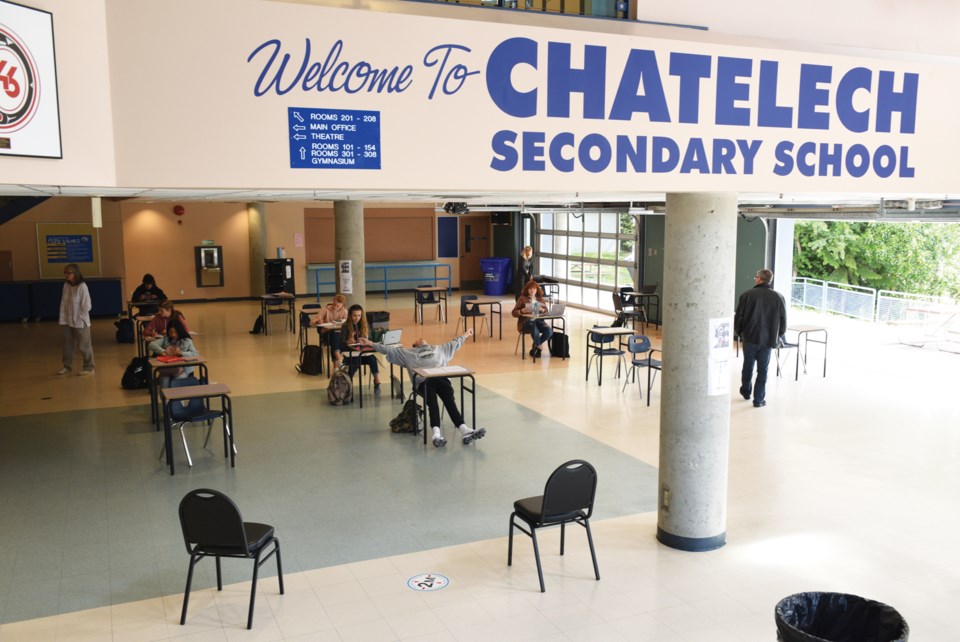Call them cohorts as B.C. provincial health officer Bonnie Henry did, or “schools within a school,” as School District No. 46 (SD46) superintendent Patrick Bocking did – whatever they’re called, they’re going to shape how school looks and feels this September.
“There will be no tournaments, there will be no assemblies, there will be no large group gatherings where people from outside areas would be coming together,” said Henry during a July 29 media briefing announcing the September return to school.
School is set to restart Sept. 8 under Stage 2, which will see students returning for full-time instruction and corralled into “learning groups” expected to stay together throughout the school term, with a maximum of 60 students and staff in elementary and middle school and up to 120 in secondary school.
There is some flexibility for how those cohorts will be organized, depending on the size of the school, for example.
All school districts will be required to submit plans to the Ministry of Education and post details online by Aug. 26.
In a letter circulated to parents following the announcement, Bocking said principals, managers and district staff will be developing details later this August.
He described the cohort organization as a “school within a school concept in which a particular group of students are associated with a specific group of staff,” with each “school” on breaks and learning separately from other groups.
He also noted staff will be pulling from a survey of SD46 families conducted earlier this summer to formulate plans. “We don’t have all the answers yet, but we do have important experience from opening in June that will be a good starting point for moving forward.”
During the briefing, Henry asked “families, employers to please continue to be flexible,” acknowledging that authorities expect COVID-19 cases will occur but the goal is to minimize the risk of transmission.
The size difference in learning groups contributes to that effort to reduce risk.
They are smaller for younger ages “due to the recognition that younger children are less able to consistently implement personal measures such as hand hygiene, reducing physical contact and recognizing and articulating symptoms of illness,” according to public health guidelines from the BC Centre for Disease Control (BCCDC), updated July 29.
The guidelines say “the use of cohorts in schools allows for a significant reduction in the number of individual interactions, while allowing most students to receive in-person learning in a close-to-normal school environment.”
In support of the changes, the B.C. government has earmarked $45.6 million in additional funding to enhance cleaning regimes and hire more cleaning staff. Some of that funding will be spent on reusable masks for staff and students, though they are not mandatory.
Education Minister Rob Fleming said during the briefing efforts to get most students back into classrooms has been spurred by the need for young people to interact with their peers.
But not everyone is happy with the plans as they stand.
The Sept. 8 full-time return “is too much too soon given the many unanswered questions in today’s announcement,” said B.C. Teachers’ Federation (BCTF) president Teri Mooring after the announcement. She was not present at the briefing.
The union as well as teachers advising the province had assumed the return would be closer to the gradual reopening that took effect in June. “The whole idea that this was going to be a full return of students came at the last minute,” said Mooring. “We were alerted to it the day before.”
She said the union would prefer to stick to a gradual approach and welcomed Fleming’s overtures during the briefing to continue collaborating over the summer.
Those views were echoed by Sunshine Coast Teachers’ Association president Jacquie Shelemey, who told Coast Reporter the announcement was a surprise.
“The ‘cohort’ model seems to be based more on efficiency of contact tracing if or when there is an outbreak, rather than any type of pedagogy, which is understandable, but then the government should be giving teachers and staffs time in September to figure out how to make education and the day-to-day running of schools mesh with this model. If anyone can make this work, it’s teachers but they need time to do that,” she said.
The BCCDC says children are at a much lower risk of developing and transmitting COVID-19 than adults and they have much milder symptoms.
However, the guidelines also note evidence of confirmed transmission within school settings remains limited, in part because most schools closed when the pandemic first hit.
For additional information, SD46 asks parents and caregivers to refer to news.gov.bc.ca/releases/2020EDUC0040-001415
Questions can be emailed to: [email protected]
– With files from Tyler Orton and Stefan Labbé



